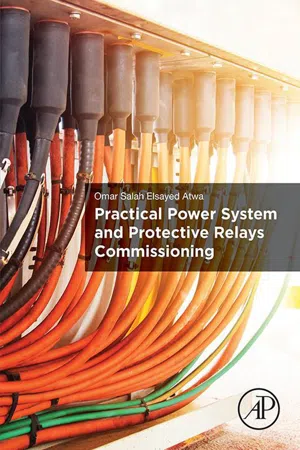
- 420 pages
- English
- ePUB (mobile friendly)
- Available on iOS & Android
Practical Power System and Protective Relays Commissioning
About this book
Practical Power System and Protective Relays Commissioning is a unique collection of the most important developments in the field of power system setup. It includes simple explanations and cost affordable models for operating engineers. The book explains the theory of power system components in a simple, clear method that also shows how to apply different commissioning tests for different protective relays. The book discusses scheduling for substation commissioning and how to manage available resources to efficiently complete projects on budget and with optimal use of resources.- Explains the theory of power system components and how to set the different types of relays- Discusses the time schedule for substation commissioning and how to manage available resources and cost implications- Details worked examples and illustrates best practices
Frequently asked questions
- Essential is ideal for learners and professionals who enjoy exploring a wide range of subjects. Access the Essential Library with 800,000+ trusted titles and best-sellers across business, personal growth, and the humanities. Includes unlimited reading time and Standard Read Aloud voice.
- Complete: Perfect for advanced learners and researchers needing full, unrestricted access. Unlock 1.4M+ books across hundreds of subjects, including academic and specialized titles. The Complete Plan also includes advanced features like Premium Read Aloud and Research Assistant.
Please note we cannot support devices running on iOS 13 and Android 7 or earlier. Learn more about using the app.
Information
Power System Elements
Abstract
Keywords
1.1 Introduction
1.2 Overview of a Power System
1.2.1 Generation of Power
- 1. Thermal generating stations that use fuels such as coal, oil, and gas that are burnt to generate electricity.
- 2. Hydro generating stations that depend on water flow through a turbine to drive the generator.
- 3. Nuclear generation stations that depend on uranium to generate electricity (nuclear fuel).
1.2.2 Transmission System
1.2.3 Distribution System
1.2.4 Loads
1.3 System Voltages
- Generation voltage levels range from 12 to 33 kV.
- Transmission voltage levels range from 110 to 800 kV.
- Distribution voltage levels range from 4 to 35 kV.
1.4 Power System Components

1.5 IEEE Device Numbers and Functions for Switchgear Apparatus
Table of contents
- Cover image
- Title page
- Table of Contents
- Copyright
- Introduction
- Chapter 1. Power System Elements
- Chapter 2. Substations
- Chapter 3. Introduction to Testing and Commissioning of Power System
- Chapter 4. Generators and Motors: Theory and Testing
- Chapter 5. Power Transformers Theory Testing and Commissioning
- Chapter 6. Transmission Lines Theory Testing and Commissioning
- Chapter 7. Circuit Breakers Theory Testing and Commissioning
- Chapter 8. Air Insulated System Substations Theory and Testing
- Chapter 9. Surge Arresters Theory Testing and Commissioning
- Chapter 10. Traditional and Electronic Current Transformers Theory Testing and Commissioning
- Chapter 11. Voltage Transformers
- Chapter 12. Disconnecting Switches and Earthing Switches Theory Testing and Commissioning
- Chapter 13. Fault Recorders in Substations and Power Stations
- Chapter 14. Gas Insulated System Substations
- Chapter 15. Batteries
- Chapter 16. Power System Fault Analysis
- Chapter 17. IEC 61850 Protocols Used in Protective Relays Communication
- Chapter 18. Protection Relays
- Chapter 19. Protection Relays Settings
- Chapter 20. Protective Relays Testing and Commissioning
- Chapter 21. A Guided Practical Value of Some Test Results Collected From Actual Power System Testing at Site
- Chapter 22. Final Substation Primary and Energization and Loading Tests
- Chapter 23. Substation Testing and Commissioning Time Schedules and Resources Management
- Index